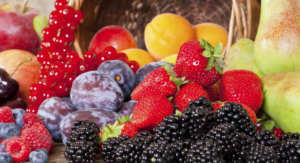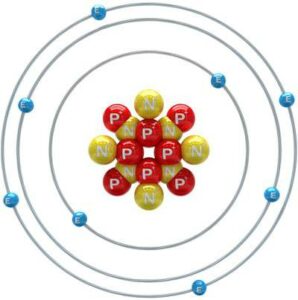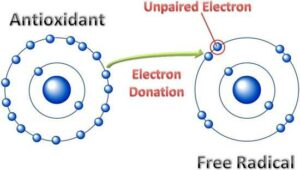Totally radical

Consuming five to nine servings of fruits and vegetables per day assures one’s diet delivers the necessary antioxidants for optimal health.
Some of the most compelling evidence supporting a diet rich in fruits and vegetables – endorsed by every significant health and science organization – revolves around studies showing those who eat more plant-based foods lower their risk of all-cause mortality.
Ever wonder why and how these foods exert such a strong health effect?
Well, different fruits and vegetables contain a group of compounds termed antioxidants, and it is these substances that are the responsible “protective” ingredients.
What are antioxidants?
To understand antioxidants we need first to review a little basic biology. The figure here is a simple diagram of an atom, composed of a core containing protons and neutrons. Electrons revolve around the perimeter.

Electrons orbit the protons and neutrons at the core of an atom.
The blue balls are electrons, which carry a negative (-) charge, while the protons (red balls) in the core carry a positive (+) charge. When two or more atoms are linked together, they become molecules.
Humans and other organisms maintain their structure and function by chemical reactions. Collectively, all of the chemical reactions needed to sustain life are known as metabolism. In these chemical reactions, bigger molecules break down into smaller molecules, and smaller molecules organize into bigger molecules.
For a molecule to be stable, it must contain the necessary number of electrons. If the molecule loses an electron (when it isn’t supposed to), it may turn into a free radical. Most free radicals are unstable, electrically charged molecules in cells that can react with and damage other molecules, such as DNA. They also can cause chain reactions, in which the molecules they damage become free radicals. Free radicals form constantly during metabolism.
Enter the antioxidant. If a molecule loses an electron and turns into a free radical, the antioxidant molecule steps in and “gives” the free radical an electron, effectively neutralizing it, and preventing biologic harm.
Free radical production brings its own side benefit. For example, the body’s immune cells use free radicals to kill invading bacteria; thus the body needs free radicals as well as antioxidants to keep them in check.
Oxidative stress

If a molecule loses an electron and turns into a free radical, the antioxidant molecule steps in and “gives” the free radical an electron, effectively neutralizing it, and preventing biologic harm.
When free radical production goes unchecked, it leads to a condition termed oxidative stress. During oxidative stress, critical molecules in the body can become severely damaged. For example, free radicals can trap a low-density lipoprotein (LDL) in an artery wall to begin forming plaque. Free radicals can damage DNA or they can change the course of what enters and leaves a cell. Any of these actions can trigger initiation of cancer and heart disease, and the development of Alzheimer’s disease, arthritis, cataracts, diabetes, kidney disease, and even age-related blindness.
Several biologic, environmental, and psychological factors — and even certain lifestyle habits — are known to promote excessive free radical formation and increased oxidative stress.
Below is a list of known factors implicated in increased oxidative stress:
-
- Air pollution
- Cigarette smoke
- Alcohol intake
- Toxins
- High blood sugar levels
- Sun radiation
- Antioxidant deficiency
- Excessive intake of antioxidants
- Infections by bacteria, fungi, or viruses
- Over-exercising
- Too much oxygen in the body
- Too little oxygen in the body
- Excessive intake of iron, magnesium, copper, or zinc
- Psychological stress
Antioxidants are essential for health
While humans can generate antioxidants, such as the cellular antioxidant glutathione (produced by the liver), the majority of antioxidants must be consumed. While some meat products and fish contain some antioxidants, depending on the types of plant food they consume, fruits and vegetables themselves constitute the major sources of dietary antioxidants.
The table below shows several types of antioxidants, their food sources, and potential benefits.
| Type, components, sources, and potential benefits of different antioxidants | ||
|---|---|---|
| Type/Components | Source | Potential Benefit |
| Carotenoids | ||
| Beta-carotene | carrots, various fruits | Neutralizes free radicals that may damage cells; bolsters cellular antioxidant defenses |
| Lutein, Zeaxanthin | kale, collards, spinach, corn, eggs, citrus | Contributes to healthy vision |
| Lycopene | Tomatoes and processed tomato products | Contributes to prostate health |
| Flavonoids | ||
| Anthocyanidins | berries, cherries, red grapes | Bolsters cellular antioxidant defenses; helps maintain brain function |
| Flavanols (Catechins, Epicatechins, Procyanidins) | tea, cocoa, chocolate, apples, grapes | Contributes to heart health |
| Flavanones | citrus foods | Neutralizes free radicals; bolsters cellular antioxidant defenses |
| Flavonols | onions, apples, tea, broccoli | Neutralizes free radicals; bolsters cellular antioxidant defenses |
| Proanthocyanidins | cranberries, cocoa, apples, strawberries, grapes, wine, peanuts, cinnamon | Contributes to urinary tract and heart health |
| Isothiocyanates | ||
| Sulforaphane | cauliflower, broccoli, Brussels sprouts, cabbage, kale, horseradish | Enhances detoxification and bolsters cellular antioxidant defenses |
| Phenols | ||
| Caffeic acid, Ferulic acid | apples, pears, citrus fruits, some vegetables | Bolsters cellular antioxidant defenses; contributes to healthy vision and heart health |
| Sulfides/Thiols | ||
| Diallyl sulfide, Allyl methyl trisulfide | garlic, onions, leeks, scallions | Enhances detoxification of undesirable compounds; contributes to heart health and healthy immune function |
| Dithiolthiones | Cruciferous vegetables—broccoli, cabbage, bok choy, collards | Contributes to healthy immune function |
| Whole Grains | ||
| Whole grains | cereal grains | Reduces risk of coronary heart disease and cancer; contributes to reduced risk of diabetes |
The following table explains how antioxidants work in the body, and offers sources for those antioxidants.
| Antioxidant vitamins and minerals | |||
|---|---|---|---|
| Substance | DRI | Antioxidant Activity | Sources |
| Vitamin A | 300-900 µg/d | Protects cells from free radicals | Liver, dairy products, fish |
| Vitamin C | 15-90 mg/d | Protects cells from free radicals | Bell peppers, citrus fruits |
| Vitamin E | 6-15 mg/d | Protects cells from free radicals, helps with immune function and DNA repair | Oils, fortified cereals, sunflower seeds, mixed nuts |
| Selenium | 20-55 µg/d | Helps prevent cellular damage from free radicals | Brazil nuts, meats, tuna, plant foods |
| DRI – Dietary reference intakes | |||
Clearly, the best way to get a variety of antioxidants in the diet is to eat plant-based foods that represent all the colors of the rainbow. Each color provides unique antioxidant effects. Bright orange and deep yellow fruits and vegetables like carrots, sweet potatoes, and apricots provide one type of antioxidant. Red foods like tomatoes, provide another. Green vegetables, such as broccoli and cabbage, and blue or purple foods, like blueberries and eggplant, each have antioxidant packages. Curcumin, the substance that makes turmeric yellow, is also believed to offer benefits.
Surprisingly, despite numerous studies, researchers have yet to demonstrate the substantial health benefits of supplemental antioxidants. Rather, it is the antioxidants in food that have been shown to exert the most significant influence. That is why experts from the American Heart Association, the American Cancer Society, and the American Institute for Cancer Research recommend getting antioxidants from food instead of supplements until research determines whether supplements are safe and provide the same benefits as antioxidants found naturally in food.
Best sources of dietary antioxidants
In 2010, researchers from Norway cataloged the total antioxidant content of more than 3,100 foods, beverages, spices, herbs, and supplements. The data show, conclusively, that plant-based foods introduce significantly more antioxidants into the diet than non-plant foods. The website retinafoundation.org provides a wonderful reference that details the amount of antioxidants in various foods.
In summary, the best assurance of consuming adequate amounts of protective antioxidants is to eat between five-nine servings of fruits and vegetables representing all the colors of the rainbow every day.
References
-
- Aune, D., et al. 2018. “Dietary intake and blood concentrations of antioxidants and the risk of cardiovascular disease, total cancer, and all-cause mortality: A systematic review and dose-response meta-analysis of prospective studies.” American Journal of Clinical Nutrition; 108(5):1069.
- Carlsen, M.H., et al. 2010. “The total antioxidant content of more than 3,100 foods, beverages, spices, herbs, and supplements used worldwide.” Nutrition Journal; 9: 3. doi: 10.1186/1475-2891-9-3.
- Pellegrini, N., et al. 2018. “Twenty-five years of total antioxidant capacity measurement of foods and biological fluids: Merits and limitations.” Journal of the Science of Food and Agriculture; Dec. 22. doi: 10.1002/jsfa.9550. [e-publication ahead of print]
- Rahal, A., et al. 2014. “Oxidative stress, prooxidants, and antioxidants: The interplay.” BioMed Research International; Volume 2014, Article ID761264.



Melissa Ziegler - 1975
Hi Vic,
What is your take on Steven Gundry’s Plant Paradox?
Reply